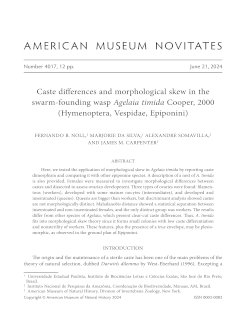Here, we tested the application of morphological skew in Agelaia timida by reporting caste dimorphism and comparing it with other epiponine species. A description of a nest of A. timida is also provided. Females were measured to investigate morphological differences between castes and dissected to assess ovarian development. Three types of ovaries were found: filamentous (workers), developed with some mature oocytes (intermediates), and developed and inseminated (queens). Queens are bigger than workers, but discriminant analysis showed castes are not morphologically distinct. Mahalanobis distance showed a statistical separation between inseminated and non-inseminated females, and the only distinct group was workers. The results differ from other species of Agelaia, which present clear-cut caste differences. Thus, A. timida fits into morphological skew theory since it forms small colonies with low caste differentiation and nonsterility of workers. These features, plus the presence of a true envelope, may be plesiomorphic, as observed in the ground plan of Epiponini.
How to translate text using browser tools
21 June 2024
Caste Differences and Morphological Skew in the Swarm-Founding Wasp Agelaia timida Cooper, 2000 (Hymenoptera, Vespidae, Epiponini)
Fernando B. Noll,
Marjorie da Silva,
Alexandre Somavilla,
James M. Carpenter






